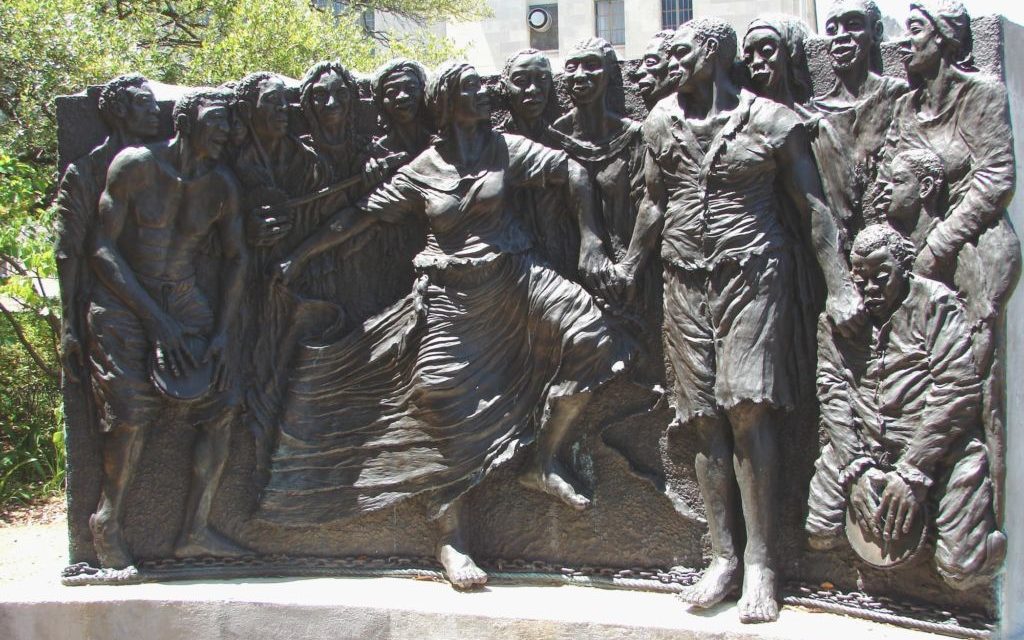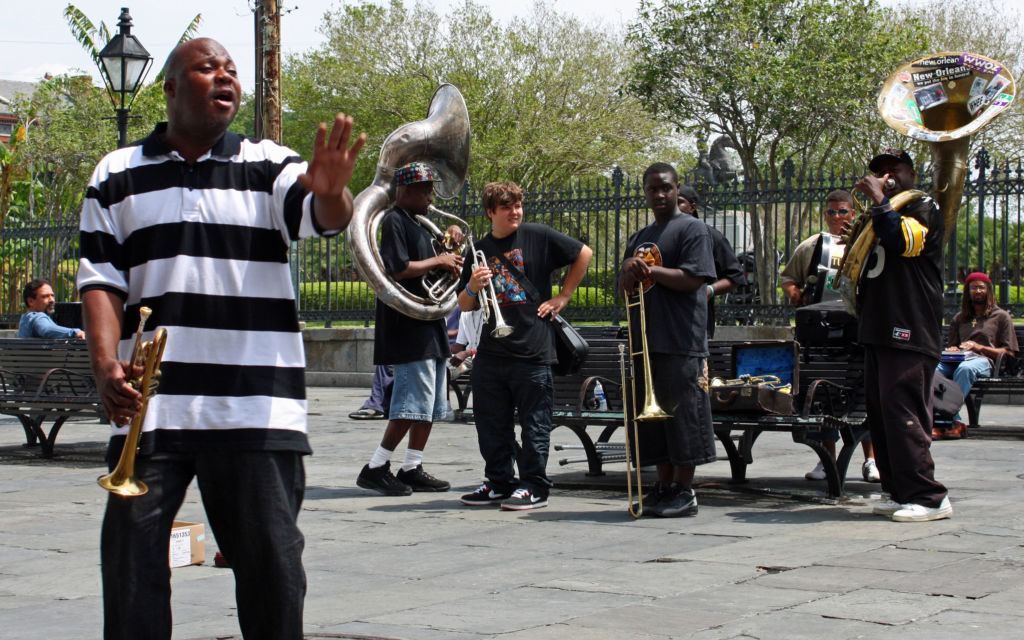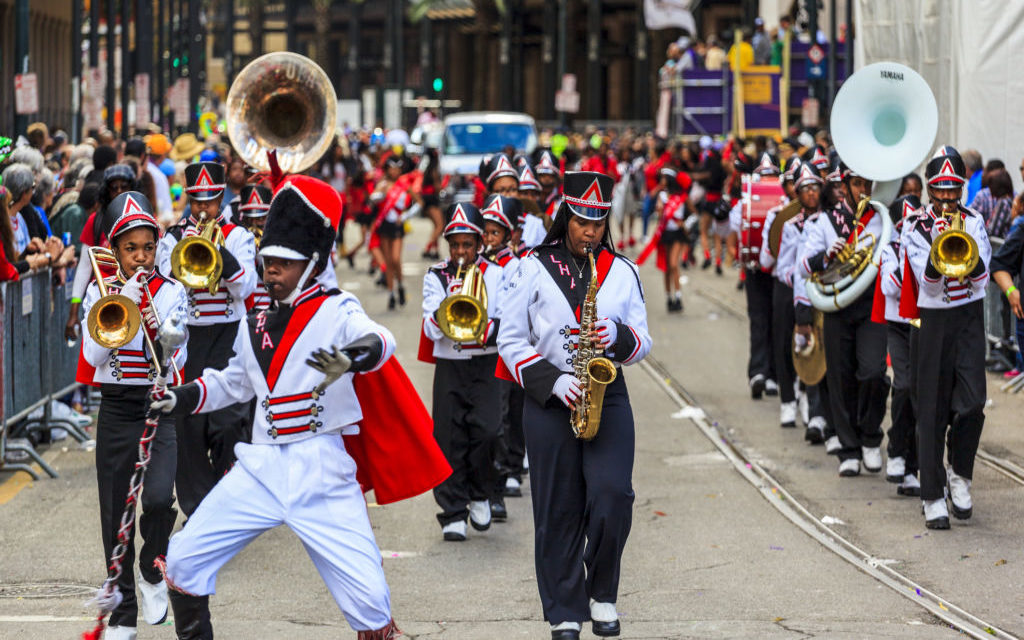Of all the different kinds of music in the American songbook, jazz is the most influential. Its story parallels that of post-Civil War America, providing a soundtrack for the country’s tumultuous history, from its roots in the West African slave trade to its proliferation across genres and the world. To learn about the origins of jazz, one has to go to New Orleans, where the history of the city shaped the sound.
Unlike the rest of English-Protestant America, French Catholics founded Louisiana in 1718, and the culture manifested in a love of drinking, food and music, especially in New Orleans. When William Claiborne took office as the first American-appointed governor of Louisiana, he called the city “ungovernable” due to its propensity for dancing. At the time, African drum performances were organized every Sunday in Tremé’s Congo Square, setting the foundation for jazz as a distinctive style of music, combining Afro-rhythms preserved in the Caribbean with European influences.

Congo Square Memorial © Allenalo | Dreamstime
New Orleans did not have homogenous, ethnic neighborhoods like many other American cities. Different kinds of people often lived closely together despite tensions, forcing a cultural exchange that would become Creole culture, people of mixed African and European descent, often working in a skilled trade. After the abolition of slavery in 1865, Creole musicians were afforded opportunities overseas. Many trained in France before coming home to work in the city’s vibrant music scene, earning New Orleans a reputation for talent.
The turn of the century marked the genre’s true birth with the development of various styles and techniques that would later become known as the foundation of jazz. Ragtime, blues and swing would spring out of the melting pot of southern culture, eventually becoming staples of the jazz artist’s repertoire. New Orleans itself gave rise to Dixieland, considered the traditional form of jazz. Brass bands flourished as the city became renowned as an entertainment hub filled with theaters, music publishers and instrument makers, meanwhile the genre spread north via riverboat bands and traveling vaudeville shows, setting the stage for its renaissance, now referred to as the Jazz Age.
The music came to symbolize the dawn of modernity on Western society by letting go of tradition and embracing the new. The Allies came out of World War I victorious while America lived under Prohibition, making jazz the soundtrack for hundreds of illegal speakeasies across the country. The Lost Generation coming home was disillusioned with the world, countering traditional values with cynicism and a desire to enjoy novel experiences. For this, jazz and dancing garnered a reputation of being an immoral and corrupting influence on youth, but authorities could do little to stop it.

© Kenneth D Durden | Dreamstime
The most significant development from this time was the solo performance, pioneered by the great Louis Armstrong. The trumpeter, skilled in New Orleans’ style of collective improvisation, took it a step further with innovative solos built on themes and chords instead of melodies. By 1930, the traditional ensemble format was a thing of the past while bandleaders and musicians experimented with style and sound.
Despite its southern black origins, musicians of all backgrounds championed jazz and crossed cultural lines, introducing the genre to audiences overseas through white and mixed-race ensembles. The 1930s saw the rise of big bands performing swing music, producing a slew of musical icons like Count Basie, Benny Goodman, Glenn Miller and more. Racial segregation was relaxing in the North, so it wasn’t uncommon for bandleaders to recruit black musicians, many of whom would go on to lead their own bands and have successful solo careers. Big band, undoubtedly the most popular style of music in the 30s and 40s, helped develop the ensemble-solo arrangement, where individual musicians would punctuate the band’s performance with improvised solos.
Recorded music was available but not very common in the early 20th century. Not many jazz records were released in Europe either, but several musicians visited the continent during and after World War I, sparking an interest in an equally disillusioned group of young people. The genre was well received in France, where local musicians mixed southern black techniques with their classical training. The Jazz Age might have been its renaissance, but it wasn’t until the 40s it became an iconic piece of culture.

Mardi Gras © Imagecom | Dreamstime
Much of the credit goes to Duke Ellington, so pivotal in the genre’s growth he even rejected the term, opting to call his style “American music.” The man is revered for breaking out of swing’s mold and fusing popular music with art. His band, considered one of the best of all time, was followed by a generation of performers that pushed jazz beyond its original limits. While New Orleans was famous for dancing, the early 40s saw the rise of bepop, which utilized fast tempos and experimental techniques for a style that challenged listeners to understand its sound instead of merely dancing to it.
By this time, jazz was a cultural force that grew beyond its roots, but there was also a growing interest in its New Orleans origins. Dixieland underwent a revival in the late 40s after record labels began selling reissues of earlier releases. Midwesterners performed much of the music, but New Orleans had a presence as well. Despite the revival’s commercial success, critics paid more attention to forward-thinking subgenres like hard bop, modal jazz and free jazz. The polyphonic texture of New Orleans jazz resurfaced with the explosion of Afro-Cuban jazz, emerging out of New York’s Latinx-dance scene.
Today, the New Orleans Jazz & Heritage Festival celebrates the genre’s rich history every year. The inaugural event took place in 1970, when George Wein, the brainchild behind the Newport Jazz Festival and the Newport Folk Festival, was hired to produce a festival for New Orleans, based on the popular Louisiana Heritage Fair. The lineup featured Mahalia Jackson, Duke Ellington, Fats Domino and even the Mardi Gras Indians, though only 350 attended the event in Congo Square. The following years were much more successful, drawing more than half a million people in 2001 and still going strong, more than 100 years after the genre’s birth.
Read This Next
Cracking Shells at the NOLA Crawfish Festival
Trends / Food & Drink
Mar 18, 2016#TrazeeTravel
Insta FeedEverline Resort & Spa Announces Spring and Summer Experiences
Everline Resort & Spa, Lake Tahoe entices travelers with its full lineup of spring and summer programming. Situated on Lake Tahoe’s California side, this resort makes the perfect getaway for guests of all ages.
Sponsored Content
AmaWaterways’ Specialty River Cruises
When you embark on a river cruise with award-winning AmaWaterways, unpack once and step aboard a world of unparalleled experiences. With enriching excursions, exquisite locally sourced food and wine, nightly entertainment and more included in the fare, you will learn why AmaWaterways has the most returning guests out of any river cruise line.
Destinations / North America
Apr 30, 2025Huttopia Debuts New Ready-to-Camp Destination in The Berkshires
Huttopia announced its newest location, Huttopia Berkshires, will open to guests in July. Reservations are now open. This marks Huttopia’s first property in Massachusetts and one of its only year-round properties in the region.
Travel
Apr 30, 2025Platform Helps Remote Workers, Business Travelers Find Work-Friendly Hotels
If you’ve ever attempted to work on the go — not necessarily for a business trip, but just because your job offers the flexibility of remote working — you may have struggled with working from your hotel room. Your options are typically plugging your laptop in next to a tiny in-room table, if you’re lucky, or you’re stuck answering emails from your hotel bed — hardly conducive to productivity.
Hotel
Apr 30, 2025Discover the Best of the Adirondacks at Schroon Lake
Looking for the perfect summer kick-off trip? The Lodge at Schroon Lake, in the Adirondacks, offers the ultimate vacation for travelers of all ages. Expect outdoor activities, beautiful scenery and lakeside fun — all the necessary ingredients for an unforgettable summer trip. Here’s a closer look at what The Lodge at Schroon Lake has to offer this summer:
Destinations / North America
Apr 29, 2025Cheapest U.S. Fall Shoulder Season Destinations Revealed
Planning ahead for a fall shoulder season (mid-September–October) trip? If you’re traveling on a budget, you’ll want to visit one of the cheapest U.S. fall shoulder season destinations.
ShareThis